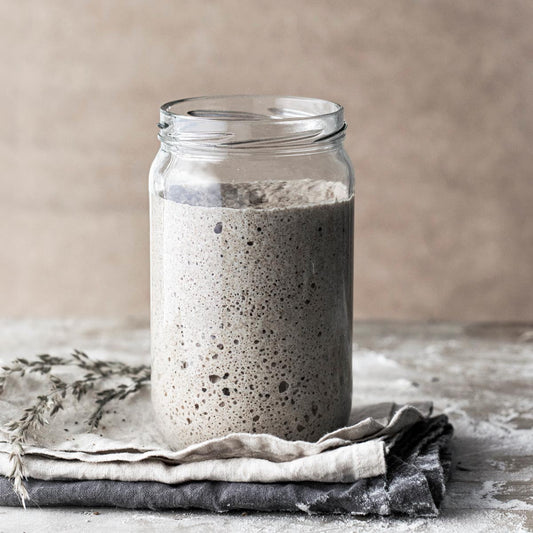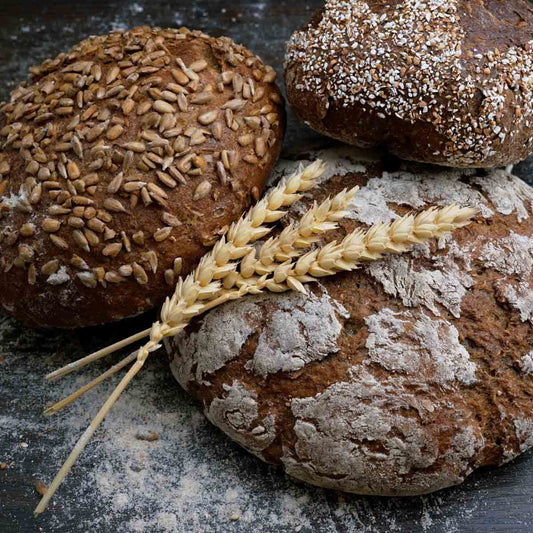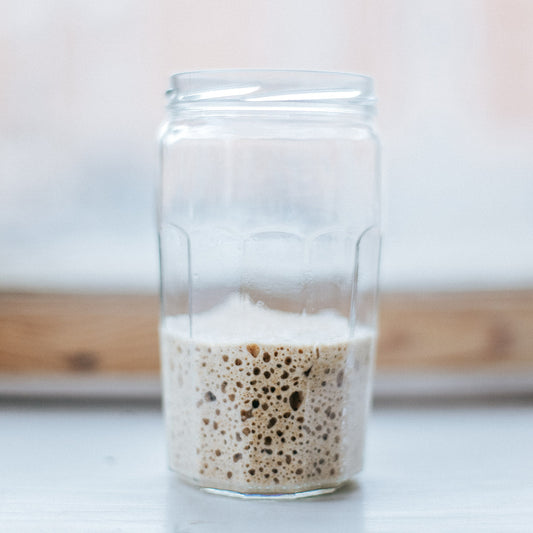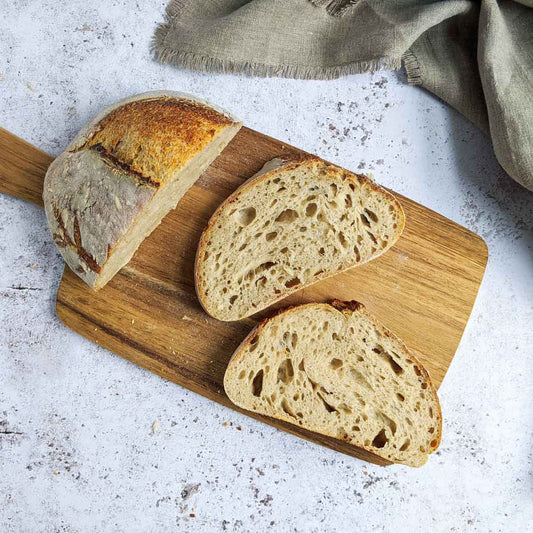Makes 1 Sourdough Artisan Loaf | Fermented: 36 hours | Bake Time: 40 minutes

This Olive Oil Sourdough Bread has a soft crumb, delightfully rich flavor, and a perfectly crackly crust. It's so good, you can eat a thick slice as is, add a dollop of pesto, or lather on a little grass-fed butter. Just grab your favorite olive oil for this beginner sourdough bread recipe.
I was inspired to make this loaf, after my partner requested an olive oil-infused bread last week. I'm telling you, it's just one of those breads that leaves your mouth watering just by the shear smell of it baking in the oven. I can't wait to hear what you think!
The main benefit of adding fat like organic olive oil or butter to our bread recipe, is that it will create a super soft and luscious texture with a thin crackly crust. It's almost like a cross between a flakey butter croissant and an artisan bread.
Why does this happen? The fatl lipids actually coat the protein strands in our dough, relaxing gluten, and making the finished product softer.
Adding fat also extends the shelf life of bread too! After a week, the bread was still soft to the touch compared to the normal artisan loaves I make. I also noticed the crust remained chewier too.

What type of olive oil should you add to your sourdough bread?
You can't go wrong here. I recently picked up a bottle of Graza and was so excited to use it. My preference is always a filtered extra virgin olive oil for both flavor and nutrition.
What supplies do you need for sourdough bread baking?
These are your bread-making essentials:
- Kitchen Scale - I recommend this digital scale or this non-digital scale
- Proofing Basket - I recommend this brand. If you don't have a proofing basket, I recommend using a Tupperware that is similar in size to the proofing basked and line it with a folded cloth so it cradle the bread. If you go this route, be sure to cover you bread with a cloth to keep it from drying out.
- Cast Iron Dutch Oven - I recommend investing in this lodge cast iron. Using a covered cast iron will your bread the rise, crust, and tender crumb you're looking for.
- Scoring Tool - I actually like to buy mine from Etsy sellers like this one but this one is also great.
- Dough Scraper
My Sourdough Bread Making Schedule
Tailor this schedule to fit your needs! I fermented this dough for a total of 3 days!
Night Before
- 10 PM: Feed your starter
Day One:
- 9 AM: Autolyse
- 11 AM: Add Starter + Salt + Olive Oil, and Mix
- 11AM - 6PM: Bulk Fermentation (with 3 Stretch & Folds)
- 6 PM: Cold Proof
Day Two
- 10 AM: Shape + Cover
- 1:00 PM: Pre-heat Oven + Dutch Oven
- 1:30 PM: Score + Bake
Ingredients for Sourdough Bread
- 400g Bread Flour - I used King Arthur Bread Flour & 20% of Farmer Ground Whole Wheat Flour
- 300g Water - I used good old fashioned tap water
- 25g Olive Oil - I used Graza - found this new brand at Whole Foods last week!
- 100g Sourdough Starter - I used Stella ;)
- 9g Sea Salt
How to make Beginner Sourdough Bread Recipe
Night Before
- 10 PM: Feed your starter
Day One:
- 9 AM: Autolyse
- 11 AM: Add Starter + Salt, and Mix
- 11AM - 6PM: Bulk Fermentation (with 3 Stretch & Folds)
- 6 PM: Cold Proof
Day Two
- 10 AM: Shape + Counter Rest
- 1:00 PM: Preheat Dutch Oven
- 1:30 PM: Score + Bake
Step 1: Feed Your Starter, 10 PM
You'll want to feed your starter about 8-12 hours before you plan to mix all of the ingredients together. Since this recipe calls for 100g of active, bubbly starter, it makes sense to feed at least 70 grams of water and 70g of flour the night before.
Step 2: Autolyse, 8 AM
In a large bowl or Tupperware, combine flour and water. Using your hands, mix the ingredients together until the dough fully absorbs the water. This will only take a couple of minutes, and there should be no dry patches left when you're done. Cover with a lid or cloth.
Step 3: Mix, 11 AM
After you've let the dough autolyse, add olive oil, sourdough starter and sea salt. Mix with your hands by slowly pinching in until incorporated. Perform 2 - 5 sets of stretch and folds.
@jesha.ann gut health >>> PART 1 of 3. OLIVE OIL SOURDOUGH BREAD … i can’t want to bake it in 48 hours 🫣 #sourdough #sourdoughbread #guthealth #healthyrecipes
♬ Chopin Nocturne No. 2 Piano Mono - moshimo sound design
Step 4: Bulk Fermentation, 11 AM - 6 PM
Bulk fermentation usually takes about 3-5 hours, but it can vary depending on the temperature of your home and the strength of your starter. My bulk fermentation took a total of 7 hours at roughly 68 F. For this step, you're going to perform 3-4 sets of stretch and folds every so often. Here's a great video showing how to do soft stretch and folds.
The bulk fermentation is done when the dough has significantly increased in size, air bubbles form on top, and air pockets on the sides and bottom. You can also perform the poke test. If you poke the dough gently with your index finger and it bounces back, retaining its original shape in the affected spot, it's a sign your dough is ready.
Step 5: Cold Proof, 6 PM
Now it's time to lay your dough baby to rest and pop her in the fridge. First, you'll need to cover it to prevent the exterior of the dough from drying out. It's pretty standard for bakers to use a plastic ziplock bag or a dampened cloth. After you've covered the dough, place it in the fridge.
Step 6: Shape + Counter Rest, 10 AM
Lightly flour your work surface, and sprinkle a little bit of flour on top of the dough as well. Shape your dough as desired and place in a covered banneton or container. Let it rest on the counter for another few hours or until slightly puffy.
Step 7: Preheat Oven, 1:00 PM
Place your Dutch oven into your oven and preheat to 500 degrees.
Step 8: Score & Bake, 1:30 PM
When the oven is preheated, cover your Tupperware/bread basket with a piece of parchment paper, and then place a cutting board over the parchment paper. While holding the parchment paper and cutting board against the Tupperware, flip it over and allow the dough to turn out.
How To Score Bread Dough
Using a scoring knife, gently score your bread at a 45-degree angle, cutting just below the skin that has formed on the outer layer of the dough.
Quickly remove your Dutch oven from the oven while being mindful of letting as little heat escape as possible. Lifting from the parchment paper edges, place your dough in the Dutch oven, add the lid, and bake at 500 for 20 minutes. After 20 minutes, remove the lid, and lower the temp to 450. Continue baking for another 20 - 30 minutes. The bread is done when the crust is a beautiful golden brown and the internal temp is about 208-210 degrees.
Allow the bread to cool (at least one hour) before slicing into it. Or, don't wait and cut into after 15 minutes. Slather with grass-fed butter of course.





